News
Bat Cave
We have a large live underground cave on the property that has been explored twice, once by the spelunkers from the University of Texas. The bat cave is fascinating site to see. During the summer months, visitors can catch the Mexican Free-tailed Bats flying out at sunset.
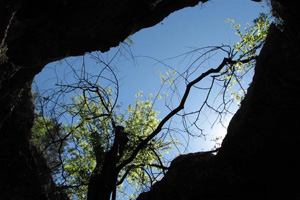

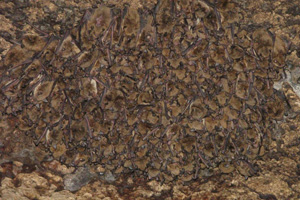
Photography & Birding
The ranch offers wonderful opportunities for wildlife photography and nature viewing so if you’re not a hunter, bring a camera. The Texas Hill Country is the home to a large number of native and migratory birds as well as many species of butterflies.



EMERGENCE OF A LEGACY
Barbara Kana reclaimed the health of her family's homestead through sound wildlife management .The West Kerr Ranch looked like a war zone when Barbara Kana first began managing the property in 1990. The land had been continually over-grazed and there were few cross fences limiting the range of domestic livestock such as goats and cattle: the deer stood along the ranch roads, hungry and listless, and watched her truck pass by. "The wildlife were hurting and undernourished," she said. "That' s when I started looking for a way to change things." The West Kerr Ranch, comprising approximately 10,000 acres, is located 45 miles northwest of Kerrville. Barbara's father purchased the land in 1976, and although she had no background in wildlife management, she had a strong tie to the land and the desire to learn. "I' d, looked at this ranch as a playground," she said. "I took pictures, I took hikes, I hunted and I shared long rides with my daughters, Kelcie and Ashley. When I started managing this ranch, I could see what was wrong but had no idea how to fix it. It seemed an over whelming task was ahead.
Kana first removed all livestock from the property and discontinued grazing leases. With assistance from the Texas Parks & Wildlife Department (TPWD),she conducted a white-tailed deer census, using the spotlight survey technique. "It was the first official census I'd ever done," she said. "And it was great. I didn't know how useful it would be until three or four years later when I began to see a pattern in how the population management programs were working." Fielding Harwell, a technical guidance biologist with TPWD, worked with Kana and developed a wildlife management plan. With that plan, Kana learned how many deer, livestock or exotic animals the land could support and techniques for improving the habitat. "She has been extremely aggressive in following the principles of wildlife habitat management," said Harwell. "I'm working with 120 ranches involving over 540,000 acres and she is at the top of those ranches. Last October, she received the Texas Society of Range Management's Award for Excellence In Rangeland Management, which reflects her commitment to the land."
My most difficult challenge has been controlling the invading cedar," said Kana. "If someone in Texas can figure out how to keep cedar from taking over their ranch without breaking the bank, that will be a real accomplishment." Many ranchers believe that goats control invading cedar, and their Edwards Plateau ranches have a manicured look, as though someone used hedge trimmers to prune every live oak's lower branches. "Goats eat the cedar only after they've eaten everything else ; plants that a deer needs to survive," she said. "You will see some pieces of land in this area that don't have cedar. But on their live oak trees, you won't see a leaf below five feet because the goats stand on their hind legs and create a definite browse line. I believe it would be possible to manage goats in a way that wouldn't be harmful to wildlife; however, it's hard to balance many types of domestic animals with the needs of white-tailed deer and other grazing animals such as axis and fallow deer." Kana attended workshops and seminars to expand her knowledge of wildlife management and range management. One of the tools described was prescribed burning."
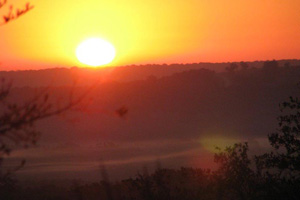


Prescribed burning discourages the cedar growth, and acts as a natural fertilizer for forbs such as clovers and other legumes.My initial reaction to using fire was, gosh, that's crazy!'" said Kana. "I pictured everything going up in smoke. But I knew from prior experience that if I cut the cedar and didn't do anything else, the cedar would come back and my money would've been pilfered away. That's why the idea of burning was attractive. It scared me, but economically, it made sense. You have to do something to prevent the cedar from coming back. We burn safely, and under the right weather conditions during the winter, and have had no problems. Safe conditions depends upon the individual area to be burned and various weather conditions. A good rule of thumb is 30-35 percent humidity with a wind 5-10 m.p.h., and the temperature between 60-70 degrees. If there is ground cover of heavy slash ( the flat cut cedar), the burn is conducted with a higher humidity of 40 percent because the fire burns much hotter. The humidity protects the soil as well.” "We never burn under 20 percent humidity," said Kana. "And we've never burned with the wind over 12 m.p.h. The experts discourage staging a burn with wind over 15m.p.h. and I wouldn't. A healthy amount of fear is a requirement when you're burning. If you lose your fear on a burn ,you're just liable to lose your fire."
“The biggest change I've noticed is in the amount of forb production and the amount of browse that has come back as a result of burning," said Kana. "In late spring, there is a foot or two of high grass in our pastures, and shin oak and hackberry flourish. Our deer are fat because they're in the gourmet section of the supermarket. They've got the best quality food available to them." Kana's management plan successfully combines basic and essential management practices. The first is the livestock management program. "We're on a rotational grazing system of cattle only, and we're very lightly stocked," said Kana. Grazing is deferred for up to one year in a selected pasture in order to grow fuel for prescribed burns. Kana now uses fire as her second management tool, burning 10 to 15 percent of the ranch each year. "Population control is the third big tool we use," she added. "We try to make sure that the numbers of domestic animals, white-tailed deer and exotic populations are in balance with the range carrying capacity. We strive to keep our buck-to doe ratio close to one-to-one.”
Kana continued attending seminars and experimenting with the new information she assimilated. "At first, I'd sit there and not ask questions, because what I was hearing sounded like Greek and I really didn't know what questions to ask," she said. "So I listened. I made phone calls. I was able to get ahold of some books and started reading. Some were too technical, books to fall asleep by. However, I didn't need to concern myself with some of the technical aspects. I left that in Fielding Harwell’s capable hands." Kana's mentors are too numerous to mention. She credits all those who assisted her, from the Texas Parks and Wildlife Department to the Natural Resources Conservation Service, for their patience and willingness to help.

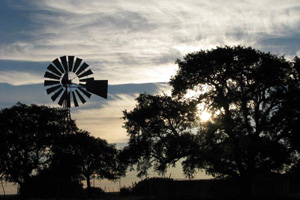
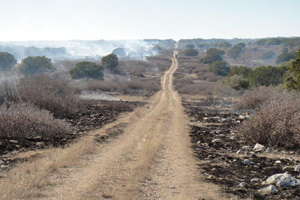
"Being a woman and stepping into a man's world was an obstacle in the beginning," said Kana. "I don't like to talk about gender issues, but I have to admit that I was fortunate to work with people who weren't intimidating. I was not afraid to ask 'stupid' questions because the gentlemen I worked with never looked down on me. Managing this ranch began as an almost insurmountable project Now, sometimes even I can't believe how far the ranch has come in such a short time. Within two years, we began to see a dramatic change in antler development and the body size of our deer. And I never would have believed that could have been possible in the beginning. The vegetation has made a dramatic return and the deer are healthy once more.”
Kana also suggests that an individual land owner's personality can strongly influence their success in implementing a management plan. "Trust your instincts," said Kana. "And then you'll need a lot of patience. I remember during the first year or two, I wanted to do it all at once. I wanted to see huge changes, and I wanted to see them yesterday. It takes a lot of patience to wait for results. Finally, landowners must be willing to take risks and not second guess their decisions. I love sharing what I've learned, but it's not an exact science," she continued. "There's a lot of guess work in the management of a piece of property. There are a lot of decisions that need to be made and you don't always know if they were the right decisions until some later date.”
The TPWD hopes to make West Kerr Ranch a demonstration area, an example for other landowners of what is possible. "She's making the land more productive from an economic standpoint, but she's approaching it from an ecological perspective," said Harwell. "The ranch is a source of income, and it's a renewable resource that's improving and becoming more productive. The land continually sustains quality deer and now attracts hunters from across Texas, from other states, and across the globe." The West Kerr Ranch has earned recognition from the Texas Big Game Awards for bucks scoring 130 or higher on the Boone and Crockett system for scoring trophy deer. "Our largest buck harvested had 12 scorable points and grossed 154 Boone and Crockett," said Kana. Kana grew up hunting and, as a single mother, raised both of her daughters as hunters. Her oldest daughter, Kelcie, learned to spot deer by the time she was a year old. "I was taught to respect the land, and it's been a dream of mine to work on the ranch, managing the land and the wildlife," said Kelcie. "I love to hunt, and that will never change. I'm lucky, because I was given the opportunity as a child to have a place to hunt. My mom is giving me a chance to fulfill my dream." Kelcie now serves as one of the ranch's most popular guides. Although men also guide during the busy fall hunting season, most of the staff are women. "I've been hunting all my life," said Barbara Kana. "I've guided my children and I've learned about the outdoors. I knew what I was doing, but I was apprehensive about guiding guests in the beginning. But ,I've never had anyone say, 'Oh, she's a woman, she doesn't know what she's doing.' The reaction has always been just the opposite."


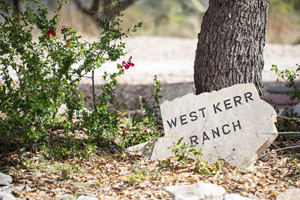
Most hunters’ associate hunting with fall and winter, but the West Kerr Ranch also offers an active spring and early summer season with turkey and exotic hunts. "You can harvest exotics year around," said Kana. "Of course, our most popular season is white-tailed deer season. The deer hunter is going to come back year after year to harvest from an eight-point to a 10-point to a I2-point buck, and from a I5-inch spread to a 17-inch spread to a 20-inch spread rack. We really focus on the quality of our white-tailed deer, and everything we do to provide a healthy environment for our native deer helps our exotic population as well."
Kana prefers to host small groups of six or eight hunters on package hunts. "We strive to make each hunter feel like he/she is the only hunter on the place," said Kana. The hunts are guided, and while Kana and her staff make every effort to accommodate the individual's hunting style, whitetail deer hunts are conducted from blinds only. "It's partly a safety factor" she said. "Also, we find that fewer animals are wounded when they are harvested from a stationary location." Kana believes honesty and integrity are important when leasing for hunting. "We love hunting," she said. "Why else would we be doing this? I go to great pains not to misrepresent my ranch and what I have to offer here," she said. "I let hunters know they're not coming to a luxury hotel. They often ask, 'What's my deer going to score? I give them a range of deer we see here. I think it's important to not misrepresent the product, and I don't try to sell something I don't have. That hurts hunting as a sport and hurts your relationship with your clients."

Kana has worked closely with Michelle Gloger, a converted' city girl' who brought her computer skills and endless enthusiasm to the ranch. "It did not take me long to realize that I preferred sunlight in the outdoors to fluorescent lights in a six -story building," said Gloger. "Barbara and this ranch have taught me nature skills and the meaning of land stewardship." Gloger, who did not hunt as a child, now is an avid hunter, proving that an urban childhood is no reason to be shy about the outdoors. An exciting encounter with nature waits just outside the city limits. In the future, Kana plans to expand her operation to include other recreational activities. "I hope hunting is around for a long, long time, but there are other recreational activities that we could offer here, such as birding, camping and camera safaris," she said. "People love to come out and sit in a blind to observe the wildlife, or ride in a vehicle and take pictures. Some like to come out and just camp, grill hamburgers and take hikes."
More than anything, she hopes her efforts will preserve the land for future generations. "I've seen artwork depicting the tall grass prairies that once covered the Hill Country, and I want to restore this ranch so my children and grandchildren will have a place they can be proud of," said Kana. The rugged hills silhouetted against a clear morning sky can lull visitors and landowners alike into a false sense of well-being, while the sun rise paints a rose colored glow over the challenges that lie ahead for the Texas Hill Country and The West Kerr Ranch. Kana studies the landscape every day and her plan is simple. "My ultimate goal," she said, "is to leave this land better than I found it."
TEXAS' TOP LAND STEWARD
G. ELAINE ACKER
Rebirth of a Hill Country Ranch
Barbara Kana is a private person. A soft-spoken mother of two, she grew up in South Texas, roaming the Matagorda seashore, and discovered a love of hunting as she crawled through the salt grass marsh to take a closer look at a flock of geese. "Goose hunting was my first 'call of the wild,'" she says. "I still get goose bumps every fall when I hear the first flock of geese. heading to Matagorda County from the skies above the West Kerr Ranch." Now a resident of Kerrville, she pushes aside the past and prefers discussions of the present: her daughters, Hill Country vegetation, controlled burns, or guided hunts. But it is the journey from the past to the present that shaped Barbara Kana's passion for the land, and made her this year's most outstanding Lone Star Land Steward.
Each year, landowners in 10 ecological regions statewide are recognized as outstanding land stewards, but only one receives the top honor. Fielding Harwell, a TPW technical guidance biologist, has worked closely with her throughout the long process of creating and implementing management plans that are changing West Kerr Ranch from a rocky wasteland to vibrant grassland. "Barbara has carried out a well-rounded habitat management program," says Harwell. "She's increasing the quantity, quality and diversity of range plants, and this not only helps the key species such as white-tailed deer, but other wildlife indigenous to the Edwards Plateau. She's good about setting goals, developing procedures, evaluating the program as it progresses and making modifications as needed. " West Kerr Ranch is situated 45 miles northwest of Kerrville in an area often characterized by scrub brush, rocky pastures and invading cedar. According to Harwell, it is not unusual for ranches in Kana's area to be overstocked with cattle, sheep and goats, and overpopulated with deer. "In a lot of that country, we're losing plant diversity, and the higher quality plants are the first to disappear," says Harwell. "Good quality grasses such as Indian grass, side oats gramma and little bluestem are on the increase on Barbara's property. She's seen an increase in trees, shrubs, and vines - the browse plants that are important to a deer's diet. There is a rapid recovery of live oak, shin oak, redbud, hackberry, greenbriar, chittum and Spanish oak.
"What impresses me most," Harwell continues, "is her ability to work with fire, and conduct winter burns. Fire is a very good management tool, but I know a lot of people who shy away from using it because they're scared of it. It demands respect because it's something that can get out of hand. Barbara has that respect."
The obstacles to Kana's success were numerous. The past that she rarely discusses ultimately shaped her future. Painful events included the death of her husband when her girls, Ashley and Kelcie, were only four and eight years old, and conflicts with a father who believed ranches were to be managed by "good-old-boy ranchers" who had spent their lives with cattle and goats. He looked at the land primarily as an investment.
As Kana renewed her strength, she began to work closely with Michelle Gloger, a converted 'city girl' who brought her computer skills and endless enthusiasm to the ranch. Kana looked at the land with her heart and saw what was possible, both for the land, and for herself "The personal challenges changed my perspective," says Kana. "I began to create an identity for myself, and part of that identity was the ranch. I saw through a different pair of eyes and was able to understand what was really happening to the ranch." Kana then reached beyond her fears and found the courage to make a change. Through a family land swap, she acquired 2,800 acres of the family's then 11,OOO-acre holdings, and began researching ways to restore the land.
But more obstacles lay ahead. She and Gloger began in 1989 during a drought period, and one consulting biologist warned them not to expect too much, too soon. "We were just starting out, and we had the feeling that we were too late," says Kana. "That feeling stayed in the back of our minds for the next year and a half as we discontinued the grazing leases, removed goats and cattle, and began trying to control the cedar. Then the rains returned, and the spring of 1991 was awesome."
Kana remembers staring at a painting of the tall grass prairies that once characterized the Edwards Plateau and thinking, "So this is what this land looked like. How can it possibly look like that again?" Driving across the ranch that spring, she stopped and watched a cedar cutter. He was working in grass up to his waist, and it was her first victory.
Another victory came in 1994 when Kana's father transferred management of the family's entire holdings into her now proven, capable hands. "For four years, I had to drive by the other family pastures that were still being overgrazed, and it was so sad," she says. 'Id look across the fence at a sea of goats still on the ranch. The wildlife was suffering." Once management was entrusted to Kana, she instituted a system of rotational grazing, reduced the number of cattle, and removed the goats altogether. She now tries to ensure that the numbers of domestic animals, white-tailed deer, and exotic animal populations are in balance with her range's carrying capacity, and she offers guided hunts in season throughout the year. Some of her most popular hunts include turkey and axis buck in the spring, and white-tailed deer (that have earned recognition from the Texas Big Game Awards) in the fall.

Kana's philosophy of land ownership reflects her respect for native American populations who believed that the land did not belong to man, but rather, man belonged to the land. "For some reason, this piece of property has been entrusted to me, and it's my responsibility to take care of it," she says. The emotional bond Kana feels with the land is shared with her children, Ashley and Kelcie. Together, the three spent countless hours driving the ranch roads, hunting, and watching the wildlife just outside their door. "Mother Nature never leaves you with nothing to look at," says Kana. "And sometimes she shares a once in a lifetime experience, like the time we saw two turkeys mating. The girls were 11 and 14, and that was a big deal." Ashley is now attending college, and Kana says she is beginning to "pass the torch" to Kelcie, who has assumed many of the management duties: supervising ranch hands, checking fences, windmills and stock tanks, filling feeders, meeting with biologists, and guiding hunts.
Kana deeply appreciates being recognized as one of the state's top land stewards, though she seems uncomfortable in the limelight.
She acknowledges that awards can be a good thing if they offer insight into the methods and techniques other landowners have used, and highlight the technical resources available through agencies such as TPWD. "Some people may not know where to begin, but I hope they'll recognize that there are tools they can use. They can read, learn, and begin to improve their land," she says. "Maybe they'll hear about this award and think 'if she did it, I can do it."
Call for reservation (830) 329-5171














